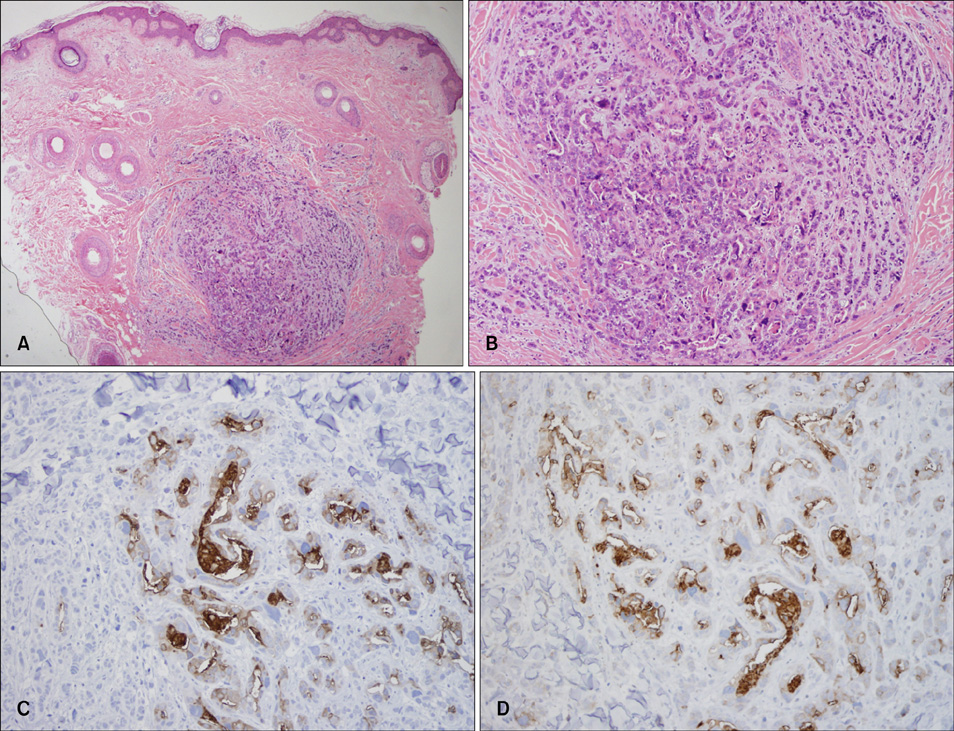Ann Dermatol.
2009 May;21(2):164-167. 10.5021/ad.2009.21.2.164.
A Case of Esophageal Adenocarcinoma Metastasized to the Scalp
- Affiliations
-
- 1Department of Dermatology and Cutaneous Biology Research Institute, Yonsei University College of Medicine, Seoul, Korea. kwanglee@yuhs.ac
- KMID: 2219387
- DOI: http://doi.org/10.5021/ad.2009.21.2.164
Abstract
- Cutaneous metastases from internal malignancies are, occurring in 0.5% to 9% of cases. Lung, breast, and colorectal cancers are common primary tumors that metastasize to the skin; cutaneous metastasis usually occurs on the chest wall and abdomen as asymptomatic nodular patterns. Esophageal cancer is not nearly as common as breast, lung, and colorectal cancers, and esophageal cancer rarely metastasizes to the skin. Cutaneous metastasis of esophageal cancer is rare and metastasis to the scalp is extremely rare. Only a few cases of cutaneous metastases of esophageal cancer have been reported in Korea. Most of the cases involved cutaneous metastases arising from esophageal squamous cell carcinoma; however, there have been several reports describing cutaneous metastases from esophageal adenocarcinomas. Herein, we describe a case of metastatic skin cancer that originated from esophageal adenocarcinoma.
Keyword
MeSH Terms
Figure
Reference
-
1. Spencer PS, Helm TN. Skin metastases in cancer patients. Cutis. 1987. 39:119–121.2. Schwartz RA. Cutaneous metastatic disease. J Am Acad Dermatol. 1995. 33:161–182.
Article3. Poole S, Fenske NA. Cutaneous markers of internal malignancy. I. Malignant involvement of the skin and the genodermatoses. J Am Acad Dermatol. 1993. 28:1–13.
Article4. Quint LE, Hepburn LM, Francis IR, Whyte RI, Orringer MB. Incidence and distribution of distant metastases from newly diagnosed esophageal carcinoma. Cancer. 1995. 76:1120–1125.
Article5. Kim JH, Rhee PL, Lee JH, Lee H, Choi YS, Son HJ, et al. Prevalence and risk factors of Barrett's esophagus in Korea. J Gastroenterol Hepatol. 2007. 22:908–912.
Article6. Park YK, Lee SH, Choi JS, Lee SN, Park CI, Lim NI. Metastatic tumor of the skin: clinical and histopathologic study. Korean J Dermatol. 1981. 19:609–618.7. Kim YC, Cho KH, Lee YS, Ham EK. Cutaneous metastasis from internal malignancy. Korean J Dermatol. 1987. 25:213–221.8. Lee CN, You CE, Park HJ, Park CJ, Cho SH, Lee JY, et al. Metastatic cancer of the skin: clinical and histopathologic study. Korean J Dermatol. 2002. 40:1212–1218.9. Saeed S, Keehn CA, Morgan MB. Cutaneous metastasis: a clinical, pathological, and immunohistochemical appraisal. J Cutan Pathol. 2004. 31:419–430.
Article10. Schoenlaub P, Sarraux A, Grosshans E, Heid E, Cribier B. Survival after cutaneous metastasis: a study of 200 cases. Ann Dermatol Venereol. 2001. 128:1310–1315.11. Lookingbill DP, Spangler N, Sexton FM. Skin involvement as the presenting sign of internal carcinoma. A retrospective study of 7316 cancer patients. J Am Acad Dermatol. 1990. 22:19–26.12. Lookingbill DP, Spangler N, Helm KF. Cutaneous metastases in patients with metastatic carcinoma: a retrospective study of 4020 patients. J Am Acad Dermatol. 1993. 29:228–236.
Article13. Smith KJ, Williams J, Skelton H. Metastatic adenocarcinoma of the esophagus to the skin: new patterns of tumor recurrence and alternate treatments for palliation. J Cutan Pathol. 2001. 28:425–431.
Article14. Pera M, Cameron AJ, Trastek VF, Carpenter HA, Zinsmeister AR. Increasing incidence of adenocarcinoma of the esophagus and esophagogastric junction. Gastroenterology. 1993. 104:510–513.
Article15. Rice TW, Adelstein DJ, Zuccaro G, Falk GW, Goldblum JR. Advances in the treatment of esophageal carcinoma. Gastroenterologist. 1997. 5:278–294.16. Riley S, Wah T. Cutaneous metastasis of esophageal adenocarcinoma with an unusual presentation. J Clin Ultrasound. 2007. 35:289–292.
Article17. Ormsby AH, Goldblum JR, Rice TW, Richter JE, Falk GW, Vaezi MF, et al. Cytokeratin subsets can reliably distinguish Barrett's esophagus from intestinal metaplasia of the stomach. Hum Pathol. 1999. 30:288–294.
Article18. Mohammed IA, Streutker CJ, Riddell RH. Utilization of cytokeratins 7 and 20 does not differentiate between Barrett's esophagus and gastric cardiac intestinal metaplasia. Mod Pathol. 2002. 15:611–616.
Article19. Yi JH, Moon WS, Yun SK, Kim HU, Ihm CW. Clinicopathological study on metastatic skin cancer. Korean J Dermatol. 2006. 44:567–573.20. Shin JH, Jeong CW, Min HG, Lee ES. Two cases of cutaneous metastases originating from esophageal carcinoma. Korean J Dermatol. 2000. 38:971–974.21. Kim CW, Kim YJ, Kim SY, Nam SH, Lee JJ. A case of squamous cell carcinoma metastasized from esophageal carcinoma. Korean J Dermatol. 2002. 40:983–985.
- Full Text Links
- Actions
-
Cited
- CITED
-
- Close
- Share
- Similar articles
-
- Alopecia Neoplastica due to Gastric Adenocarcinoma Metastasis to the Scalp, Presenting as Alopecia: A Case Report and Literature Review
- A Case of Metastatic Adenocarcinoma on the Scalp from the Rectum
- A Case of Primary Esophageal Adenocarcinoma Originated from Ectopic Gastric Mucosa in the Upper Esophagus
- A Case of Squamous Cell Carcinoma Metastasized from Esophageal Carcinoma
- A Case of Cutaneous Metastases to the Face and Scalp from Colon Adenocarcinoma



